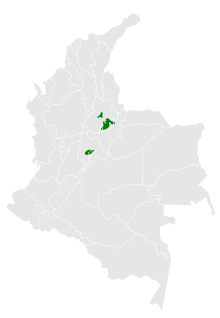
Quail is a collective name for several genera of mid-sized birds generally placed in the order Galliformes. The collective noun for a group of quail is a flock, covey, or bevy.

The Caucasian grouse or Caucasian black grouse is a large bird in the grouse family. It is closely related to the black grouse.
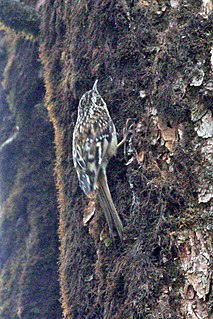
The Sichuan treecreeper is a rare species of bird in the treecreeper family, Certhiidae.
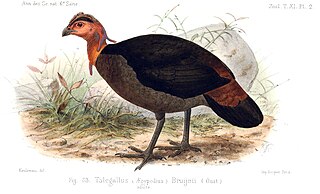
The Waigeo brushturkey or Bruijn's brushturkey, is a large brownish-black megapode with a bare red facial skin, red comb, maroon rump and chestnut brown below. There are two elongated red wattles on the back of the head and a long wattle on the foreneck. Both sexes are similar. The female has a smaller comb and no wattles.

The Réunion cuckooshrike is a passerine bird in the cuckooshrike family. It is endemic to the island of Réunion, where it is restricted to two areas of mountain forest in the north of the island. Males are dark grey above and pale grey beneath, while females have dark brown upper parts and a streaked breast. The population has been declining and the range contracting, being currently about 16 square kilometres (6.2 sq mi), and the International Union for Conservation of Nature has rated the species as "critically endangered", with the possibility that the bird could be wiped out by a tropical storm. Conservation efforts are being made by attempting to control the cats and rats which prey on the chicks, and this seems to have resulted in the population stabilising.
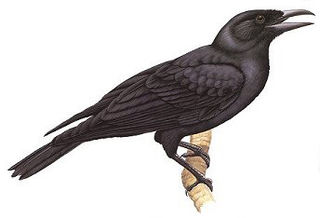
The Mariana crow is a species of the crow family from the South Pacific. It is a glossy black bird about 15 inches (38 cm) long and known only from the islands of Guam and Rota.

The gorgeted puffleg is a Critically Endangered species of hummingbird in the "brilliants", tribe Heliantheini in subfamily Lesbiinae. It is endemic to Colombia. It was discovered in 2005 and confirmed as a species new to science in 2007.

The black-fronted wood quail is a bird species in the family Odontophoridae, the New World quail. It is found in Colombia and Venezuela.

The spot-winged wood quail is a species of bird in the family Odontophoridae. It is found in Brazil, Argentina and Paraguay, and formerly in Uruguay. In Portuguese and Spanish the bird is called uru.

The Venezuelan wood quail is a bird species in the family Odontophoridae, the New World quail. It is found in the Venezuelan Coastal Range.

The Tacarcuna wood quail is a species of bird in the family Odontophoridae, the New World quail. It is found in Colombia and Panama.

The black-breasted wood quail is a bird species in the family Odontophoridae. It is found in Costa Rica and Panama. Its natural habitat is subtropical or tropical moist montane forest.

The black-eared wood quail is a bird species in the order Galliformes. Until recently, the species was thought to be part of the family Phasianidae however DNA-DNA hybridization results determined that black-eared wood quail are only distantly related to Old World quail. As a result, black-eared wood quail have been placed in the family Odontophoridae and more specifically, in the category of wood quail.
The yellow-legged pigeon is a bird species in the family Columbidae. It is found in the Bismarck and Solomon archipelagos. Its natural habitats are subtropical or tropical moist lowland forests and subtropical or tropical moist montane forests. It is threatened by habitat loss. It was formerly classified as Endangered by the IUCN. But new research has shown it to be not as rare as it was believed; consequently, it was downlisted to Vulnerable in 2008.

The Rondônia bushbird is a bird species in the family Thamnophilidae. It is endemic to Brazil.

The rufous flycatcher is a bird species in the family Tyrannidae. It is endemic to Peru. Its natural habitats are subtropical or tropical moist lowland forests and subtropical or tropical dry shrubland. It was formerly classified as a species of least concern by the IUCN. But new research has shown it to be much rarer than it was believed. Consequently, it is uplisted to endangered in 2008.

The Yungas antwren or ashy antwren is a bird species in the family Thamnophilidae and is endemic to Bolivia.

The Bolivian recurvebill is a bird species in the family Furnariidae. It is endemic to Bolivia.
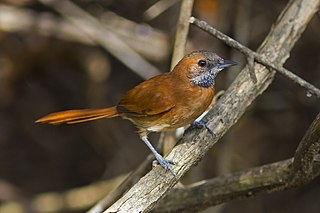
The hoary-throated spinetail is a bird species in the family Furnariidae. It is found in Brazil and Guyana.

The Himalayan cutia is a bird species in the family Leiothrichidae. Its scientific name ultimately means "the khutya from Nepal", as Cutia is derived from the Nepali name for these birds, and nipalensis is Latin for "from Nepal".
